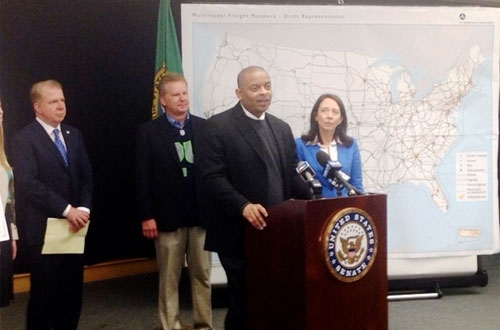National Freight Strategic Plan provides roadmap to freight transport challenges
Written by Mischa Wanek-Libman, editor
The U.S. Department of Transportation (USDOT) released the draft National Freight Strategic Plan that offers specific policy proposals and solutions to address the challenges of moving freight in the U.S.
The draft plan is open for comment and is called “an essential step for continuing to support the nation’s economy through the efficient movement of goods, while recognizing and responding to future infrastructure challenges.”
USDOT says that while freight traffic has increased, which is good news for the economy, concerns surrounding the ability of U.S. infrastructure to accommodate continued growth persist. USDOT says that in the next 30 years the population of the United States is expected to grow by 70 million people and freight traffic is expected to increase by 42 percent by 2040.
“With an increasingly competitive and complex global marketplace and a deteriorating transportation infrastructure that is unfortunately showing the effects of age and underinvestment, the need for us to have a national freight plan could not be more urgent,” said U.S. Secretary of Transportation Anthony Foxx.
He called the draft plan a first-of-its-kind document that takes a comprehensive look at the nation’s freight needs and future challenges and offers a roadmap for improvements.
The draft plan’s specific strategies include:
- Ensure dedicated freight funding: The draft plan emphasizes the importance of a dedicated freight program that would improve the movement of freight and meet regional economic demand and would require or incentivize State Freight Advisory Committees, State Freight Plans, and cross-jurisdictional/cooperative planning. The administration introduced and supported GROW AMERICA Act would provide $18 billion over six years through two dedicated, multimodal freight grant programs for targeted investments.
- Identify major trade gateways and multimodal national freight networks/corridors: USDOT is releasing a draft Multimodal Freight Network (MFN) map to inform planners, private sector stakeholders, and the public about where major freight flows occur and where special attention to freight issues may be most warranted. USDOT and the U.S. Department of Commerce have monitored and analyzed major trade gateways and freight corridors for decades, but the draft MFN combines the most critical modal components and shows the connections between them.
- Facilitate multijurisdictional, multimodal collaboration and solutions: USDOT will continue its work to support local, State, and interagency collaboration, including close cooperation with port authorities, private sector stakeholders, and agencies in Canada and Mexico; sharing best practices for freight planning; supporting advisory committees and public forums with stakeholders; and encouraging effective use of funding available at the national level.
- Ensure availability of better data and models: USDOT will continue to develop and deploy newer and more advanced freight data resources to the planning community and advance the measurement and analysis of transit times for different commodities from a multimodal, origin-to-destination perspective. Congress could enhance USDOT’s authority to collect intermodal freight data by giving USDOT’s Bureau of Transportation Statistics the authority to assemble intermodal freight movement data under the Intermodal Transportation Data Program, as proposed in the GROW AMERICA Act.
- Improve safety and support the adoption of new transportation technologies: USDOT is undertaking new and innovative efforts to improve freight transportation safety. The Department recently announced the formation of a National Coalition on Truck Parking to improve commercial driver safety. USDOT will also efforts to adopt new and exciting transportation technologies, including autonomous vehicles that promise to allow for safer and more reliable freight transportation.
- Develop the next generation freight transportation workforce: USDOT is committed to promoting economic opportunity through high-quality transportation jobs as part of the President’s Ladders of Opportunity Initiative. Efforts include developing freight skills for State transportation agency and MPO staff through a growing body of resources and guidance on freight planning, and pushing for greater authority to develop workforce plans.
USDOT says it welcomes the public to provide feedback and comment on the draft National Freight Strategic Plan. To submit your thoughts and to learn more about the draft plan, visit www.transportation.gov/freight





